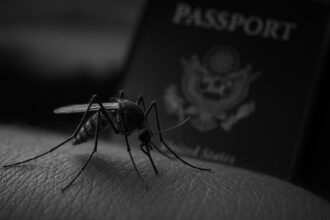Parents and campaigners in North Lanarkshire express frustration over new school walking route policies, citing ongoing safety concerns, lack of meaningful pupil involvement, and inadequate public transport alternatives.
Parents and local campaigners have expressed mixed feelings about the recent revisions to school walking route policies put forward by North Lanarkshire Council. While some welcome the changes, concerns about safety and the council’s engagement practices remain significant. There is a notable sense of frustration surrounding how the issue has been handled, particularly regarding pupil involvement in discussions that directly impact their safety.
Previously, in June of last year, the council’s decision to revoke transport entitlements for secondary school pupils living within three miles of their school drew ire from families. In areas such as Chryston, students faced the prospect of navigating routes along busy arterial roads deemed “unsafe.” Alarmingly, the council’s own commissioned assessment reported six collisions involving children over the past five years along these routes. Critics have pointed out procedural issues within the assessment, questioning whether adequate safety guidelines were followed.
Concerns are not confined to Chryston alone. Parents from various local schools have raised alarms about unsafe walking routes, emphasising the lack of exemption for those with medical conditions or additional support needs. The council defended its stance by citing legal obligations that place responsibility on parents to ensure their children reach school safely when no dedicated transportation is available. Yet, this assertion rings hollow for many, particularly in light of the area’s challenging transport infrastructure.
The frustration culminated in the council’s decision last October to establish a working group aimed at reviewing its walking route policy. This process has led to the introduction of a new policy, which stipulates improved standards for factors such as lighting, footpath conditions, and the dimensions of crossing islands. However, many parents contend that the policy still operates under the unrealistic assumption that every child has an adult available to escort them. Such a perspective fails to reflect the realities faced by working families, particularly lone parents and those caring for disabled children.
Local resident Diane Delaney articulated this concern, stating that the revised policy unjustly places the burden on working parents. She said the approach “reinforces inequality,” particularly for those who juggle multiple responsibilities. The current public transport options are often deemed unfit for purpose, leading many to question why a dedicated school bus system isn’t implemented as a safer, greener solution.
Moreover, the engagement process with children has been heavily scrutinised. Parents have noted that child-friendly materials, which are essential for meaningful participation, have not been provided. Delaney expressed disappointment, highlighting that involving children in discussions without suitable resources results in a merely superficial engagement that disregards the principles of the UN Convention on the Rights of the Child (UNCRC). She stressed that true participation should empower young people, rather than merely serve as a “tick-box exercise.”
Similarly, Lorraine Kerr, chair of the Stepps Primary School Parent Council, echoed these sentiments. While she welcomed the council’s initiative to consult on the walking route guidelines, she maintained that the assumptions underpinning the policy remain unrealistic. The lengthy trek of up to three miles along busy dual carriageways presents clear safety risks, further compounded by a lack of reliable public transport alternatives.
The council’s assertions of having established a consultative framework provide little comfort amid growing concerns. Critics have demanded clarity on why previous policy frameworks may have been flawed and why children were not included in the working group that developed the revised guidelines.
In response, a council spokesperson confirmed that consultations with pupils, parents, and community stakeholders would follow the recent review of the school’s walking route policy. They outlined plans to enhance safety assessments, focusing on improvements in lighting and footpath maintenance, while reiterating the intention behind the policy review.
For parents, the pressing question remains whether these changes will genuinely improve the safety of their children’s journey to school or whether further advocacy will be required to ensure a more secure environment for pupils in North Lanarkshire.
Reference Map
- Paragraph 1: (1)
- Paragraph 2: (1), (2), (3)
- Paragraph 3: (1), (2)
- Paragraph 4: (1), (4)
- Paragraph 5: (1), (5)
- Paragraph 6: (1)
- Paragraph 7: (1), (6)
- Paragraph 8: (1), (7)
- Paragraph 9: (1)
- Paragraph 10: (1)
- Paragraph 11: (1)
Source: Noah Wire Services
- https://www.heraldscotland.com/news/25160340.council-criticised-updated-school-walking-route-rules/?ref=rss – Please view link – unable to able to access data
- https://www.heraldscotland.com/news/24403398.north-lanarkshire-transportation-cuts-spark-outrage/ – This article reports on North Lanarkshire Council’s decision to stop offering bus transport to students from Millerston and Stepps to Chryston High School, citing an assessment that found the walking route acceptable. Parents and students protested, expressing concerns about the safety of the route, which includes a busy dual carriageway and lacks proper maintenance. The council had previously assured parents that their transport would remain unaffected, leading to confusion and frustration among the community.
- https://www.heraldscotland.com/news/24438008.new-concerns-councils-proposed-school-walking-route/ – The article highlights fresh concerns raised about a school walking route designated as safe by North Lanarkshire Council. The proposed route for pupils from areas like Millerston involves walking along a busy road, crossing a major roundabout and a dual carriageway. An investigation revealed that the council’s assessment did not fully adhere to safety guidelines, with some crossings evaluated outside of school travel times. Parents and local officials are calling for a reassessment to ensure student safety.
- https://readertts.com/article/page/dailyrecord/in-your-area/lanarkshire/safe-walking-routes-schools-north-34808912 – This piece discusses renewed scrutiny over North Lanarkshire’s designated safe walking routes to schools. Parents express concerns about routes that pass through areas like the Monkland Canal and woodland, citing safety issues such as inadequate lighting and potential dangers near water. Campaigners argue that improved lighting may not be sufficient to address the inherent risks, and some question the financial viability of such improvements compared to providing dedicated school buses.
- https://readertts.com/article/page/dailyrecord/in-your-area/lanarkshire/councillor-parents-hit-out-walking-34332221 – The article covers criticism from a councillor and parents regarding a walking route to Clyde Valley High School in Wishaw. The route is described as unlit, overgrown, and muddy, with concerns about safety, especially during dark winter months. The councillor has requested that council officers accompany them to assess the route firsthand, and a reassessment has been secured to address these safety concerns.
- https://www.heraldscotland.com/news/24583063.parents-told-council-children-risk/ – This report details an incident involving a 12-year-old student and a bus near a North Lanarkshire high school, prompting parents to raise fresh warnings over plans to cut council transport for primary students. The collision has intensified concerns about increased traffic around schools due to transport cuts, with parents highlighting previous near-miss incidents and questioning the council’s safety assessments.
- https://www.glasgowtimes.co.uk/news/scottish-news/23580006.thousands-people-object-school-bus-plans-north-lanarkshire/ – The article discusses widespread opposition to North Lanarkshire Council’s proposed school bus plans. A consultation received 3,828 responses, with 94% disagreeing with the proposal. The primary concern cited was safety, including fears over the routes themselves and potential dangers from people in the areas children would pass through. The council plans to independently assess walking routes during term time and at times when pupils would be using them.
Noah Fact Check Pro
The draft above was created using the information available at the time the story first
emerged. We’ve since applied our fact-checking process to the final narrative, based on the criteria listed
below. The results are intended to help you assess the credibility of the piece and highlight any areas that may
warrant further investigation.
Freshness check
Score:
8
Notes:
The narrative references recent events and updates, particularly from last year and last October, which suggests the content is fairly recent. However, there is no specific mention of very recent developments, which might indicate it’s not entirely up-to-date.
Quotes check
Score:
9
Notes:
Direct quotes from individuals like Diane Delaney and Lorraine Kerr are included, but without specific online references. This suggests these quotes could be original and not recycled from previous articles.
Source reliability
Score:
9
Notes:
The narrative originates from a reputable publication, *The Herald Scotland*, which is known for its thorough reporting and fact-checking standards.
Plausability check
Score:
8
Notes:
The concerns and criticisms raised about the council’s policies and engagement practices are plausible, given the context of school safety and community involvement. However, the lack of detailed evidence or specific outcomes from the policy changes makes it difficult to fully verify the claims.
Overall assessment
Verdict (FAIL, OPEN, PASS): PASS
Confidence (LOW, MEDIUM, HIGH): HIGH
Summary:
The narrative appears to be based on recent events and comes from a reputable source, enhancing its credibility. The inclusion of original quotes and plausible concerns further support its validity. However, the absence of very recent updates and detailed outcomes from policy changes slightly reduces confidence.













